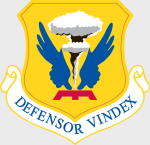Hobby Master HA3006 USAF General Dynamics F-111A "Aardvark" Strike Aircraft - "New Hampshire Special," 509th Bomb Wing, Pease AFB, 1974 (1:72 Scale)
"Defensor Vindex (Defender Avenger)."
- Motto of the 509th Bomb Wing
 The General Dynamics F-111 "Aardvark" is a medium-range interdictor and tactical strike aircraft that also fills the roles of strategic bomber, reconnaissance, and electronic warfare in its various versions. Developed in the 1960s and first entering service in 1967, the United States Air Force (USAF) variants were officially retired by 1998. The Royal Australian Air Force (RAAF) is the sole remaining operator of the F-111.
The General Dynamics F-111 "Aardvark" is a medium-range interdictor and tactical strike aircraft that also fills the roles of strategic bomber, reconnaissance, and electronic warfare in its various versions. Developed in the 1960s and first entering service in 1967, the United States Air Force (USAF) variants were officially retired by 1998. The Royal Australian Air Force (RAAF) is the sole remaining operator of the F-111.
The F-111 pioneered several technologies for production military aircraft including variable-sweep wings, afterburning turbofan engines, and automated terrain following radar for low-level, high-speed flight. Its design was influential, being reflected in later Soviet aircraft such as the Sukhoi Su-24, and some of its advanced features have since become commonplace. During its inception, however, the F-111 suffered a variety of development problems, and several of its intended roles, such as naval interception through the F-111B, failed to materialize.
In USAF service the F-111 has been effectively replaced by the F-15E Strike Eagle for medium-range precision strike missions, while the supersonic bomber role has been assumed by the B-1B Lancer. In 2007, the RAAF decided to replace its 21 F-111s in 2010 with 24 F/A-18F Super Hornets.
Pictured here is a 1:72 scale rendition of a USAF General Dynamics F-111A "Aardvark" strike aircraft that was attached to the 509th Bomb Wing, then deployed to Pease AFB, during 1974.
Sold Out!
Dimensions:
Wingspan: 12-1/4-inches
Length: 10-1/2-inches
Release Date: June 2011
 Historical Account: "Direct Descendants" - The 509th Bomb Wing (509 BW) is a United States Air Force unit assigned to the Air Force Global Strike Command, Eighth Air Force. It is stationed at Whiteman Air Force Base, Missouri.
Historical Account: "Direct Descendants" - The 509th Bomb Wing (509 BW) is a United States Air Force unit assigned to the Air Force Global Strike Command, Eighth Air Force. It is stationed at Whiteman Air Force Base, Missouri.
The 509 BW is the host unit at Whiteman AFB, and operates the B-2 Spirit stealth bomber. The wing can launch combat sorties directly from Missouri to any spot on the globe, engaging adversaries with large payloads of traditional or precision-guided munitions.
The wing's 509th Operations Group is a direct descendant organization of the World War II 509th Composite Group (509th CG). The 509th CG had a single mission: to drop the Atomic Bomb. The group made history on August 6th, 1945, when the B-29 Superfortress, "Enola Gay," piloted by Col Paul W. Tibbets, Jr., dropped the first atomic bomb on Hiroshima, Japan. The B-29 "Bockscar," piloted by Maj Charles Sweeney visited the Japanese mainland on August 9th, 1945, and dropped the second atomic bomb on Nagasaki.
The current 509 BW also led the way for America's first military response following the terrorist attacks on New York City and Washington D.C. on September 11th, 2001. B-2 bombers were the first U.S. aircraft to enter Afghan airspace in October 2001, paving the way for other coalition aircraft to engage Taliban and Al Queda forces. During this operation, the aircraft flew round trip from Missouri, logging combat missions in excess of 40 hours - the longest on record.
- General characteristics
- Crew: 2 (pilot and weapons system operator)
- Length: 73 ft 6 in (22.4 m)
- Wingspan:
- Spread: 63 ft (19.2 m)
- Swept: 32 ft (9.75 m)
- Height: 17.13 ft (5.22 m)
- Wing area:
- Spread: 657.4 ft² (61.07 m²)
- Swept: 525 ft² (48.77 m²)
- Airfoil: NACA 64-210.68 root, NACA 64-209.80 tip
- Empty weight: 47,200 lb (21,400 kg)
- Loaded weight: 82,800 lb (37,600 kg)
- Max takeoff weight: 100,000 lb (45,300 kg)
- Powerplant: 2× Pratt & Whitney TF30-P-100 turbofans
- Dry thrust: 17,900 lbf (79.6 kN) each
- Thrust with afterburner: 25,100 lbf (112 kN) each
- Zero-lift drag coefficient: 0.0186
- Drag area: 9.36 ft² (0.87 m²)
- Aspect ratio: spread: 7.56, swept: 1.95
- Performance
- Maximum speed: Mach 2.5 (1,650 mph, 2,655 km/h)
- Combat radius: 1,330 mi (1,160 nmi, 2,140 km)
- Ferry range: 4,200 mi (3,700 nmi, 6,760 km)
- Service ceiling: 66,000 ft (20,100 m)
- Rate of climb: 25,890 ft/min (131.5 m/s)
- Wing loading:
- Spread: 126.0 lb/ft² (615.2 kg/m²)
- Swept: 158 lb/ft² (771 kg/m²)
- Thrust/weight: 0.61
- Lift-to-drag ratio: 15.8
- Armament
- Guns: 1× M61 Vulcan 20 mm (0.787 in) gatling cannon (seldom fitted)
- Hardpoints: 9 in total (8× under-wing, 1× under-fuselage between engines)
- Armament capacity: 31,500 lb (14,300 kg) ordnance mounted externally on hardpoints and internally in fuselage weapons bay
- Bombs:
- Free-fall general-purpose bombs
- Mk 82 (500 lb/227 kg)
- Mk 83 (1,000 lb/454 kg)
- Mk 84 (2,000 lb/907 kg)
- Mk 117 (750 lb/340 kg)
- Cluster bombs
- BLU-109 (2,000 lb/907 kg) hardened penetration bomb
- Paveway laser-guided bombs, including:
- GBU-10 (2,000 lb/907 kg)
- GBU-12 (500 lb/227 kg)
- GBU-28, specialized 4,800 lb (2,200 kg) penetration bomb
- BLU-107 Durandal runway-cratering bomb
- GBU-15 electro-optical bomb
- AGM-130 stand-off bomb
Wingspan: 12-1/4-inches
Length: 10-1/2-inches
|


